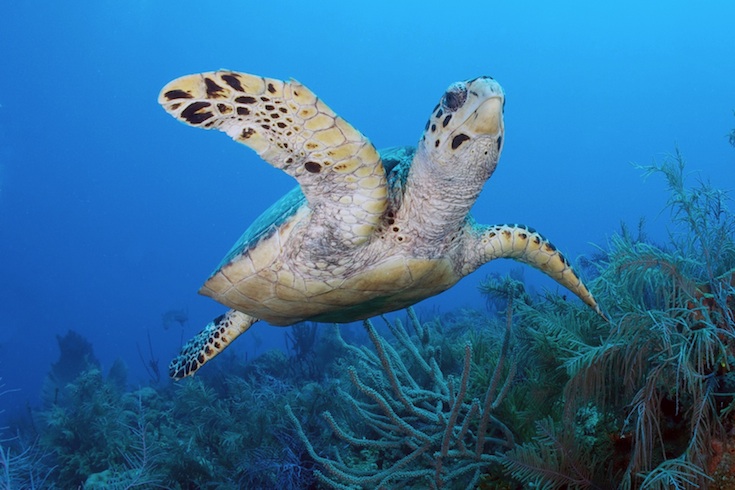10 Things to Know About Sea Turtles
Scientists have only begun to discover secrets of sea turtle life

This blog was written by Roger Di Silvestro, a field correspondent for Ocean Conservancy.
Sea turtles are among the world’s most ancient vertebrates. When on land, they look cumbersome and awkward, their powerful front flippers struggling to pull their weight across ocean shores. But in the water, where they spend most of their lives, sea turtles fly through the water much as birds soar through the sky. Their flippers become wings, their disk-shaped bodies cut through the sea like torpedoes.
Sea turtles remain one of nature’s great mysteries—scientists have only begun to discover secrets of sea turtle life. Here are ten things science can tell you about sea turtles.
1. Sea turtles are reptiles, like snakes and lizards, and breathe air. They first evolved about 150 million years ago, making them survivors of the Age of Dinosaurs. The first turtles were land animals that probably looked much like the tortoises of today, with powerful, column-like legs designed to support a heavy body. Evolution turned these elephantine legs into flippers as the creatures adapted to a life of swimming. Today turtles swim in all oceans except those in the chilly Polar Regions.
2. The most obvious characteristic of any turtle is its shell. It evolved from the ribs into a box of bone covered in tough skin that protects all but the head, tail and flippers. The shell is part of the turtle’s spine and forms a sort of outer skeleton reminiscent of the exoskeletons of insects and spiders.
3. The ocean is home to seven turtle species: the leatherback, loggerhead, Olive ridley, hawksbill, flatback, green and Kemp’s ridley.
4. Sea turtles begin life in leathery-shelled eggs laid in holes dug by their mothers in sand. Depending on the species, a female may produce 50 to 200 eggs at a time, most species laying them at night. About 60 days later, the eggs hatch within a few minutes of each other and the babies races to the sea, often assaulted by a gamut of predators like crabs, gulls, raccoons and sharks. A female may lay as many as eight clutches per breeding season. On average, about one hatchling per 1,000 survives to adulthood.
5. The largest sea turtle is the leatherback, which possesses a flexible, leathery shell. It reaches a length of four to eight feet and weighs 500-2,000 pounds—not bad for a reptile that feeds mostly on jellyfish. Its search for food can take it down to 4,000 feet and across hundreds of miles: they can easily migrate 3,600 miles each way.
6. The smallest sea turtle is the Kemp’s ridley, which measures less than 30 inches long and weighs less than 100 pounds. The Kemp’s has the most-restricted nesting range of any sea turtle species—one beach, about 15 miles long, near Rancho Nuevo in Mexico. Unlike other sea turtles, Kemp’s ridleys usually lay eggs during the day and in massive groups, called arribadas (Spanish for “arrival”). In the 1940s, an arribada typically would number around 40,000 females. By the 1980s, as a result of uncontrolled collection of eggs and meat for human food, the entire The Mexican government has enforced stricter provisions on egging, and the United States has a nesting beach in Texas where more than 100 females have laid eggs yearly for the past decade. Biologists raise the hatchlings in captivity until they are large enough to have an edge on survival, then release them from the beach where they hatched.
7. Young turtles head to the open sea, returning later to offshore and reef areas to feed. Some species travel hundreds of miles. The flatback sea turtle, however, restricts its activities to seas off Australia.
8. Sea turtles can rest underwater without breathing for up to two hours. When seeking food or evading predators, they need to surface for air more frequently.
9. All sea turtles are omnivorous when young, but the green sea turtle becomes purely herbivorous as an adult. As omnivores, the turtles will scarf down seaweed, sponges, mollusks, worms, fish and other sea life. However, leatherbacks tend to eat almost exclusively jellyfish, some of which can grow to be several feet across.
10. The average lifespan for a sea turtle is hard to nail down, given that they live for several decades and few research projects last that long. Current conventional wisdom suggests that they reach breeding age anywhere between age 3 and 50 and may live 80 to 100 years, though these figures are ballpark.